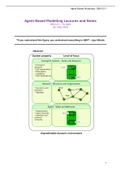Samenvatting
FULL Summary ALL Lectures and Lecture Notes - Agent Based Modelling SEN1211
A full summary of the entire 'Agent Based Modelling' (SEN1211) course given at TU Delft. It's written in English with lots of bullet points, definitions, and the important figures. It contains: 1. Summary of all theory lectures 2. Summary of all ABM-focussed lectures 3. Questions from the reca...
[Meer zien]




